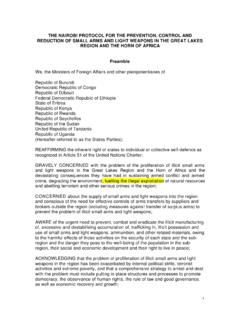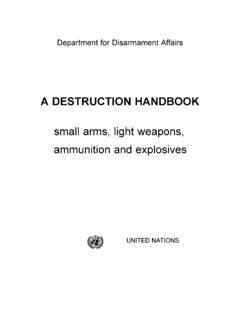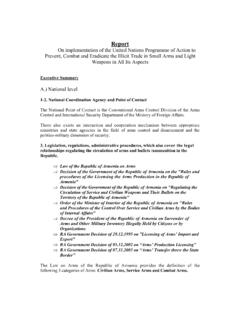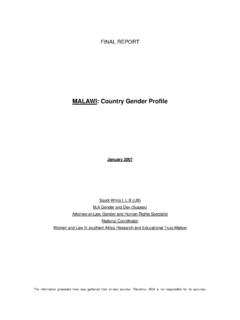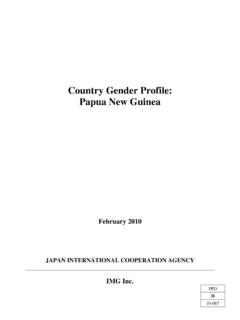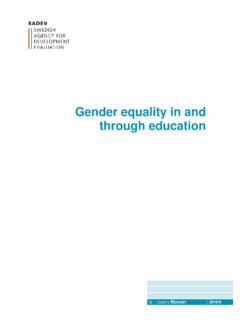Transcription of South Eastern and Eastern Europe Clearinghouse for …
1 South Eastern and Eastern Europe Clearinghouse for the Control of Small Arms and Light Weapons (SEESAC) RMDS/G 1st Edition 2007-06-01 SALW and gender Issues Head, SEESAC, UNDP Belgrade, Internacionalnih Brigada 56, 11000 Belgrade, Serbia E-mail: Telephone: (+381) (11) 344 63 53 Fax: (+381) (11) 344 63 56 RMDS/G 1st Edition (2007-06-01) i Warning This document is current with effect from the date shown on the cover page. As the Regional Micro-Disarmament Standards/Guidelines (RMDS/G) are subject to regular review and revision, users should regularly consult the RMDS/G project website in order to verify their current status: Copyright notice This document is a South Eastern and Eastern Europe Regional Micro-Disarmament Standard/Guideline (RMDS/G) and is copyright protected by UNDP.
2 Neither this document, nor any extract from it, may be reproduced, stored or transmitted in any form, or by any means, for any other purpose without prior written permission from SEESAC, acting on behalf of UNDP. This document is not to be sold. Head, SEESAC, UNDP Belgrade, Internacionalnih Brigada 56 11000 Belgrade, Serbia E-mail : Telephone: (+381) (11) 344 6353 Fax: (+381) (11) 344 6356 SEESAC 2007 All rights reserved RMDS/G 1st Edition (2007-06-01) ii Contents ii Foreword .. iii Introduction .. iv SALW and gender ..5 1 2 References ..5 3 Terms and definitions ..5 4 5 Conventions, Frameworks and 6 gender mainstreaming ..7 7 Impact of SALW on individuals by 8 Addressing the male dimensions of small arms 9 Empowering women s organisations.
3 8 10 Promoting women s political 11 Increasing gender responsiveness of security institutions ..8 Annex A (Normative) References .. 10 Annex B (Informative) 11 Annex C (Informative) Terms and 12 Annex D (Informative) UNDP gender Mainstreaming Checklist for Policy and project Documents .. 18 Annex E (Informative) .. 19 Armed Violence Impact Analysis (2007) .. 19 Annex F (Informative) .. 20 gender Engagement in SALW Functional Areas and AVPP Thematic Areas .. 20 RMDS/G 1st Edition (2007-06-01) iii Foreword On 08 May 2003 the development of regional micro-disarmament1 standards and guidelines was discussed during the RACVIAC sponsored seminar on SALW A year after Implementation of the Stability Pact Plan . The consensus was that such standards and guidelines were desirable, and SEESAC agreed to develop a framework and then take responsibility for the future development of regional standards.
4 It was agreed RMDS/G would be designed to support the work at the operational level, and would go further than the more generic best practice documents currently available. After a wide-ranging discussion between stakeholders as to the status of RMDS/G it has been agreed that the term standards will refer to the technical issues, whilst guidelines will apply to programme issues. This RMDS/G 2 reflects the development of operational procedures, practices and norms, which have occurred over the past four years in the area of Small Arms and Light Weapons (SALW)3 control. Best operational practices have been identified and reviewed from within the region and beyond, and included as appropriate within this RMDS/G.
5 SEESAC has a mandate under the Stability Pact Regional Implementation Plan to fulfil, among others, operational objectives of 1) sharing information on and enhancing co-operation in the establishment and implementation of SALW control and reduction programmes and approaches among regional actors; and 2) providing linkage and co-ordination with the other relevant regional initiatives. The development of RMDS/G is one means of fulfilling that mandate. The work of preparing, reviewing and revising these standards and guidelines is conducted by SEESAC, with the support of international, governmental and non-governmental organisations and consultants. The latest version of each standard, together with background information on the development work, can be found at RMDS/G will be reviewed at least every three years to reflect developing SALW control norms and practices, and to incorporate changes to international regulations and requirements.
6 The latest review was conducted on 01 March 2006, which has reflected the development of the UN Integrated Disarmament, Demobilization and Reintegration Standards (IDDRS) , which include RMDS/G as a normative reference in the Disarmament and the SALW Control modules. 1 Defined as: The monitoring, collection, control and final disposal of small arms, related ammunition and explosives and light weapons of combatants and often also of the civilian population. It includes the development of responsible weapons and ammunition management programmes . Often used interchangeably with SALW control in the past, but SALW Control is now the recognised terminology.
7 The term Micro-Disarmament has only been used here to ensure consistency of the RMDS/G concept, rather than renaming the standards. 2 The layout and format of RMDS/G are based on the highly successful International Mine Action Standards (IMAS). The cooperation of the UN Mine Action Service (UNMAS) is acknowledged by SEESAC during the development of RMDS/G. 3 There is no agreed international definition of SALW. For the purposes of RMDS/G the following definition will apply: All lethal conventional munitions that can be carried by an individual combatant or a light vehicle, that also do not require a substantial logistic and maintenance capability RMDS/G 1st Edition (2007-06-01) iv Introduction Small arms, light weapons and ammunition (SALW) are inherently dangerous.
8 In the wrong hands, and in sufficient quantities, they can be politically destabilising, and lead to and exacerbate conflict. As such, they can present grave dangers, both to national governments and to international and regional peace-building efforts. One of the most effective ways that they can be kept in check is by programmes for SALW control. The issue of SALW is inherently gendered . Men and women, boys and girls, have different attitudes towards and experiences with SALW, as evidenced by the available data. In SEE4 men commit 99 percent of firearms crime and make up 85 percent of the victims. Women on the other hand constitute only one percent of perpetrators but 15 percent of Clearly, when women are victims of firearms crime it is at the hands of men.
9 However, the issue of SALW and gender has not been sufficiently explored in order to inform programming. This RMDS/G represents a culmination of the research and work available to date, and aims to give guidance to those trying to mainstream gender into SALW Programmes, as well as developing specific programmes involving gender issues and SALW. This RMDS/G incorporates ideas from the SEESAC Strategy for gender Issues in SALW Control and AVPP6 Activities . 4 SEE in this case refers to the countries of the Western Balkans Albania, Bosnia and Herzegovina, Croatia, Former Yugoslav Republic of Macedonia, the UN Administered Province of Kosovo, Montenegro and Serbia.
10 5 Statistics have been extracted from the national EUSAC/UNDP Media Monitoring reports and Consolidated Armed Violence Analysis derived from those reports. In order to allow for comparisons, data is included from 01 January - 31 April 2007 only, as the Armed Violence Impact Analysis system only went live in most countries on 01 January 2007. 6 Armed Violence Prevention Programmes. RMDS/G 1st Edition (2007-06-01) 5 SALW and gender 1 Scope This RMDS/G establishes some guiding principles for addressing the SALW problem from a gender perspective. The document gives guidelines as to what kind of issues should be considered when planning projects or programmes involving gender and SALW as well as some suggested approaches and entry points.
